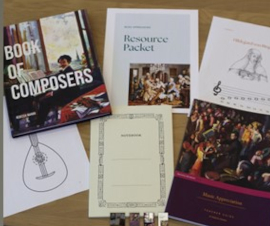Beautiful Feet Book’s Music Appreciation course for grades two through twelve should take two years to complete. The author, Rebecca Manor, recommends spending a week on each of the 54 lessons so students can listen to each composer’s works several times and become familiar with them.
The course explores music from ancient to modern times, bringing in elements from history, religion, science, and other areas. While early music was often composed for religious purposes, this is not a religious book. Religion is discussed objectively as are other philosophical influences.
The course is sold only as the Music Appreciation Pack. It has three essential components: Music Appreciation Teacher Guide, Book of Composers, and a downloadable Music Appreciation Resource Packet. (A QR code for accessing the resource packet is on page 3 of the teacher guide, but it is not clearly labeled. However you download it, you still need to print its 56 pages.) You will also be accessing a Music Appreciation Links Page with playlists of musical pieces, activity instructions, documentaries, lectures, and other lesson resources, all free online. A QR code to the playlist appears frequently in Book of Composers and the URL is in the teacher guide.
The study requires the creation of a student notebook where all work is kept, so the Music Appreciation Pack includes their own 64-page composition notebook with acid-free paper. (You might prefer that students use a binder in which they can insert pages rather than pasting some pages into the BFB notebook.)
Book of Composers
Book of Composers is a lovely, hardcover book with illustrations and information about the historical development of music, biographical information about composers, and brief stories about composers (imaginary stories based on historical information).
The book begins with a section on ancient musical instruments, about which we know much more than we do about the actual music they produced. The next section, on Medieval and Renaissance music, relates the development of musical notation by people such as Guido d’Arezzo and Hildegard von Bingen and the emergence of choral music. It also highlights composers such as Thomas Tallis and Giovanni Pierluigi da Palestrina, including performances of some of their musical works on the playlists. Following that is a much larger section on classical music that encompasses the Baroque, Classical, and Romantic periods as well as the development of instruments and the orchestra. Next, two sections divide “modern” music into Early Twentieth-Century Composers and Twentieth-Century Musical Movements with Classical Roots. The early twentieth-century composers include several women. The “musical movements” include ragtime, the blues, jazz, rock and roll, and musical theater. A few pages very briefly summarize contemporary classical music, listing five modern composers.
Teacher Guide
The Teacher Guide presents each of the 54 lessons in sections labeled Read and Listen, Discuss, Record, Explore, Do, and Rabbit Trails.
All students should participate in the Read and Listen and Discuss sections with a focus for younger students on exposure and appreciation rather than academic work. The rest of each lesson is best for students in fourth grade and above. Record, Explore, Do, and Rabbit Trails are not all included in every lesson.
Read and Listen – read from Book of Composers, listen to music from playlists, and maybe use another link from the list. Students may color pictures of composers from the Resource Packet while listening and then put the pictures in their notebooks.
Discuss – discuss what was read and listened to.
Record – students work with pages from the Resource Packet and their notebook. They might label parts of an instrument and then color the image. If they prefer, they can draw their own images. On a printable form in the Resource Packet students list each piece they listen to along with the composer’s name, rate it with a star system, and add their comments. (This is a brief form with space for three listening experiences per page.) Occasionally, students are given a prompt for a writing assignment.
Explore – takes students to the links page for a video or information to go deeper on a lesson topic.
Do – mostly hands-on activities with instructions or resources found on the links page. For instance, in one of them, students make a harmonica with popsicle sticks. In another, they watch an entertaining video about conducting an orchestra and then practice conducting. The teacher guide also has four recipes referenced in the “Do” section of the pertinent lessons that tie to particular composers.
Rabbit Trails – recommended books for extra reading. Lists and images of books are at the beginning of each section, and pertinent books are listed again at the end of each lesson.
Note: Music Appreciation replaces Beautiful Feet Book’s prior course, History of Classical Music, but it is greatly expanded and is usable for a wider age range than the original course.
Summary
Many homeschoolers are familiar with some Beautiful Feet Book courses that use several “living books” as essential course components. Music Appreciation reduces both the cost and time required by publishing their own Book of Composers as a single sourcebook. But they still include lists of many books for those who want more, and the internet links make the study multisensory with listening and other activities. Homeschooling families can use whichever components suit them, making this a flexible option that can work for all ages.









